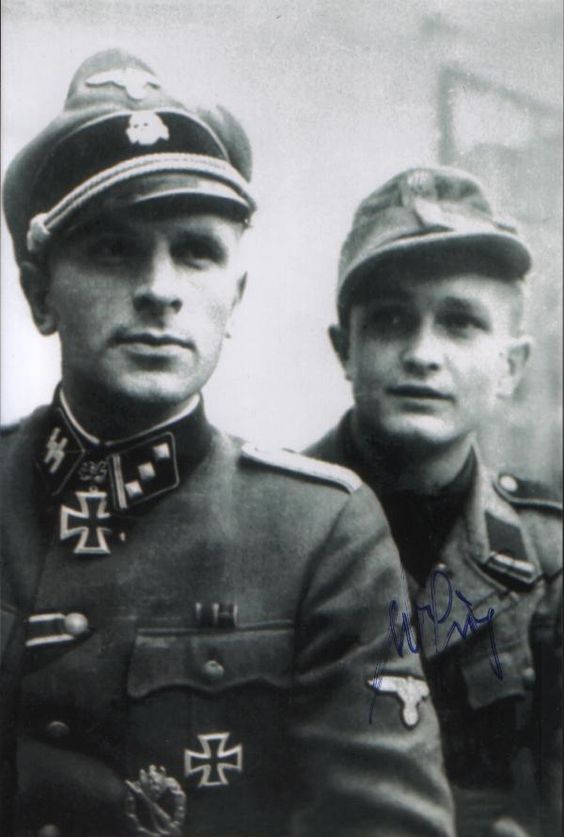Walter Girg (left).
On 24 August 1944, a Russian offensive in north-west Romania tore through the Romanian Third and Fourth Armies, allowing the Russians, in turn, to inflict heavy losses on the German Eighth Army and nearly destroy the German Sixth Army for the second time in its existence, the first having been at Stalingrad. On the same day the young King Mikhail deposed the pro-German Marshal Antonescu and ordered all German personnel to leave the country. Two days later, the new Romanian government formally declared war on Germany. While most of Germany’s former European partners followed the same pattern of surrendering to the Allies and subsequently going to war against Germany, Romania performed its volte-face with astonishing speed. In a short space of time, Germany was facing nearly twenty Romanian divisions under Russian control. German military forces in Romania and many of their families who had been comfortably far from the front now found themselves hundreds of miles behind enemy lines almost overnight.
Skorzeny received an order from the Oberkommando der Wehrmacht (OKW): ‘Form two special platoons for immediate operation to start from Temezvar airport, Romania. The object is to bar the Carpathian mountain passes, reconnoitre behind the enemy, wreck his communications and help German civilians to safety.’ The operation was codenamed ‘Landfried’ and was placed under the command of a young Untersturmführer called Walter Girg, who had been posted to Friedenthal only four months previously, directly after his commissioning at the Waffen-SS officer school at Bad Tolz.
Due to the Waffen-SS system, Girg was a hardened combat veteran and the holder of the Iron Cross in both classes even before commencing officer training. He was placed in charge of a team which included Russian speakers, demolition experts – and one incognito Irishman, whom it might be speculated was thought well of by his commanders. James Brady recalled: ‘About August 1944, about fifty members of the battalion, including myself, but not Stringer, were posted to Romania. We were in Romania for about three weeks, during which time I helped to blow up two river bridges and one railway bridge.’ At the last moment, Girg was warned that Temezar airport had fallen into Russian hands and his team instead diverted to an emergency airfield from which they commenced operations. According to Skorzeny’s account: ‘They operated behind the Russian lines, in Russian, Romanian and Bulgarian uniforms, according to the territory … Fifty men were committed, who operated 700 km behind the lines. They were divided into an eastern group, a western group and a central group. The first [Brady’s group] obstructed three passes and located appr. 2,000 men from the Ploesti AA batteries in the vicinity of Kronstadt [Brasov], of whom 250 were brought back.’ This was a German anti-aircraft regiment guarding the vital Ploesti oil fields, smartly turned out and equipped with the latest air defence artillery, who were patiently waiting to surrender to the Russians. The aforementioned 250 troops who were persuaded to stage a breakout succeeded in returning to German lines. Skorzeny recalled: ‘The western group brought back German residents and collected intelligence. The central group was under the command of Girg. It placed demolitions in the Rotenturm pass, south of Herrmanstadt [Sibiu] and observed Russian preparations in that vicinity. On one occasion they marched for about fifteen km in a Russian column. They were discovered and condemned to death. Girg however managed to escape from the firing squad and reach the German lines. He submitted a report containing valuable information on Russian order of battle and was awarded the Ritterkreuz [Knights Cross].’ According to Brady’s all too brief account of this spectacular special operation, his first time in combat: ‘There were only twenty-two of us left when we pulled out of Romania. Some men were killed by the Russians and others by the Romanians.’ Girg’s central group bore the brunt of the casualties, the other two escaping with minor losses. Interestingly, apart from Girg’s Knights Cross, two NCOs of the party were awarded the also prestigious German Cross in Gold. It would be reasonable to speculate that the nineteen remaining personnel received some lesser decoration.
